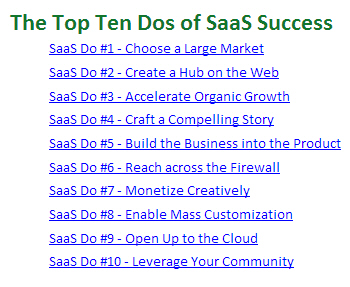Joel York has built an extensive library of SaaS related educational information through his blog Chaotic Flow. His blog posts and e-books explain strategies and best practices on important topics such as networking, monetization and churn management – knowledge that is helpful to all software vendors.
This post summarizes and analyzes the first part of York’s e-book, “Software-as-a-Service Success: 10 Dos and 10 don’ts of SaaS” in which the author showcases an insider’s understanding of proper strategies for marketing and selling SaaS applications.
The most essential concept gleaned from the book is that in order for SaaS providers to succeed in the market, they must capitalize on the social nature of today’s Internet experience. Success is earned by building social elements in the features of a SaaS product and by utilizing social tactics in marketing efforts.

SaaS success is organic and social
Businesses that understand the needs and wants that drive consumer spending can leverage this social paradigm and accelerate organic growth, which York helpfully defines in a cut-and-dry manner: Growing revenue with minimal acquisition costs.
The 10 “Dos” of SaaS success include inherently social activities like building hubs on the web (#2), nurturing organic growth (#3), storytelling (#4), allowing customization (#8), interacting with people and software through the cloud (#9), and leveraging community (#10).
Understandably, the social web makes companies nervous. Control has been taken from the business and placed in the hands of consumers who are often fickle in their desires. In today’s Internet marketplace, businesses cannot impose their own prejudices on buyers. Instead they must respond to customer demands and opinions with honesty and authenticity.
Social marketing
The key to marketing in the world of web 2.0 is a social connection which begins with a compelling story (SaaS Do #4).
Storytelling is an ancient form of communicating important ideas. But storytelling is more than narrating a sequence of events or simply listing a product’s features. A story takes data and events and molds them into understanding, into wisdom – it makes the foreign comfortable and the strange familiar. As Josh Kaufman writes in The Personal MBA, “If people don’t know who you are, they won’t pay for the value you create.”
By telling a story, companies lay the groundwork for creating hubs on the web and leveraging their communities (SaaS Dos #2 and #10). This breeds organic growth (SaaS Do #3), provided there is a large enough market for the application (SaaS Do #1). As York notes, one of the most compelling stories told by a SaaS company is Salesforce, which starts off with a simple idea: No Software.
As York points out, market size is a big factor in success. If your audience is not very large, or is currently listening to another story, chances are your venture cannot bring you profit and may be better suited to be a personal hobby rather than a business venture.
But if your message is compelling to a broad enough audience, your business has potential to become an Internet hub.
Social functionality
Meanwhile, it’s not just about the message of the company and how the service or product is marketed. It isn’t even about how people use your software. SaaS success is also about how other applications use your software.
The SaaS application itself must have social features in line with experience of web 2.0. This social functionality depends on customization and opening up to the cloud (SaaS Dos #8 and #9). Regarding this last point about opening up to the cloud, York writes:
“The disruptive shift called cloud computing is about the computers talking to each other over the Web—software interacting with other software…”
In other words, SaaS applications don’t function in a vacuum and must play well with other applications. In speaking about a SaaS-based ecommerce platform, for example, if it can’t tie in to other SaaS applications like a CRM system, it isn’t social and will have difficulty bringing in revenue.
Using creative examples from Amazon, Salesforce, Twitter, Google and others, York illustrates the positive aspect of turning a web experience into a business model. For example, Amazon’s basic service of delivering physical goods is not that different from a mail order catalog. Where Amazon differentiates from your traditional catalog is its SaaS features: Internet based checkout, order management, support, affiliate programs spread across the web, search, recommendations, one-click checkout, etc.
Monetization
Creative monetization (SaaS Do #7) is an important part of this conversation as well. With recurring, usage-based, tiered functionality, etc. SaaS providers will need to find the best value for them and their customers in order to be successful.
Another way to creatively monetize a SaaS product is by allowing mass customization (SaaS Do #8). SaaS vendors have a unique ability to enable and disable certain features that customers may be willing to pay more to use.
Keystone
Given the popularity of the Internet, making it (the Internet) into a product that you can sell is a very compelling business decision. SaaS is a huge opportunity to transform a product into a powerful Internet-based service. SaaS takes a product and builds it into a web experience.
For more SaaS related know-how, check out Joel York’s blog Chaotic Flow.